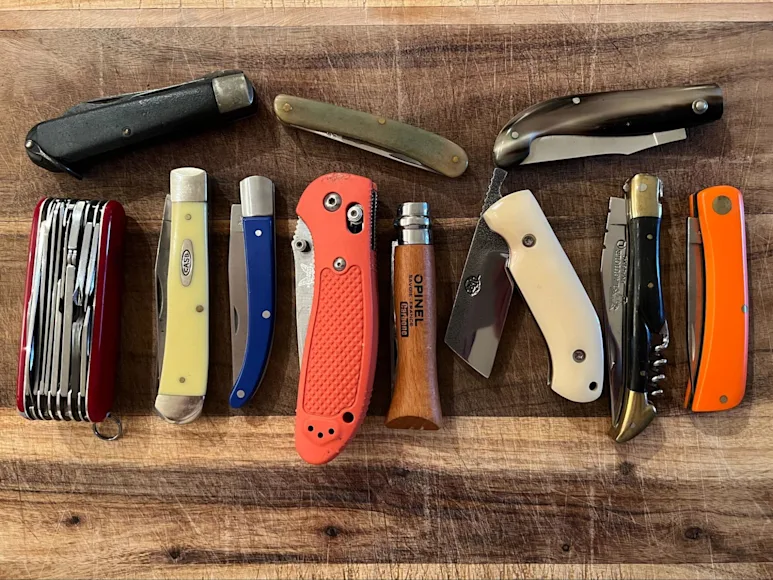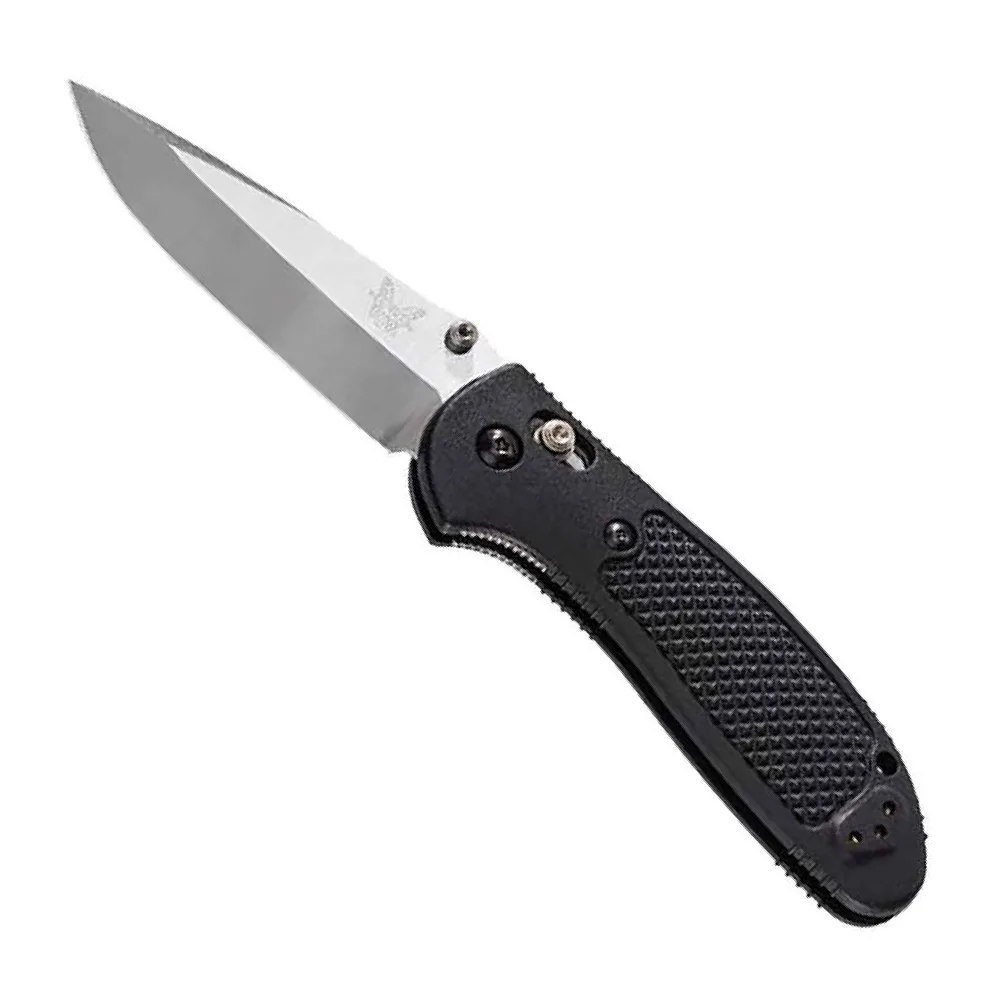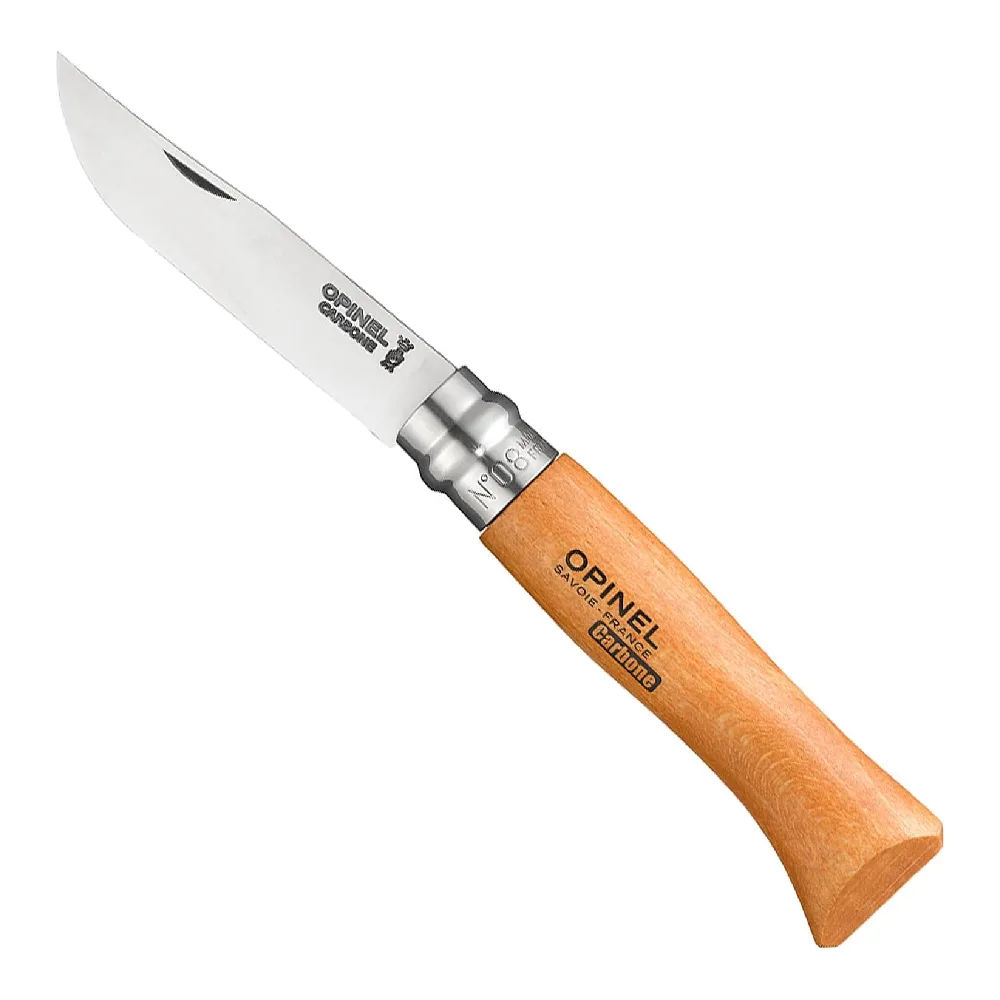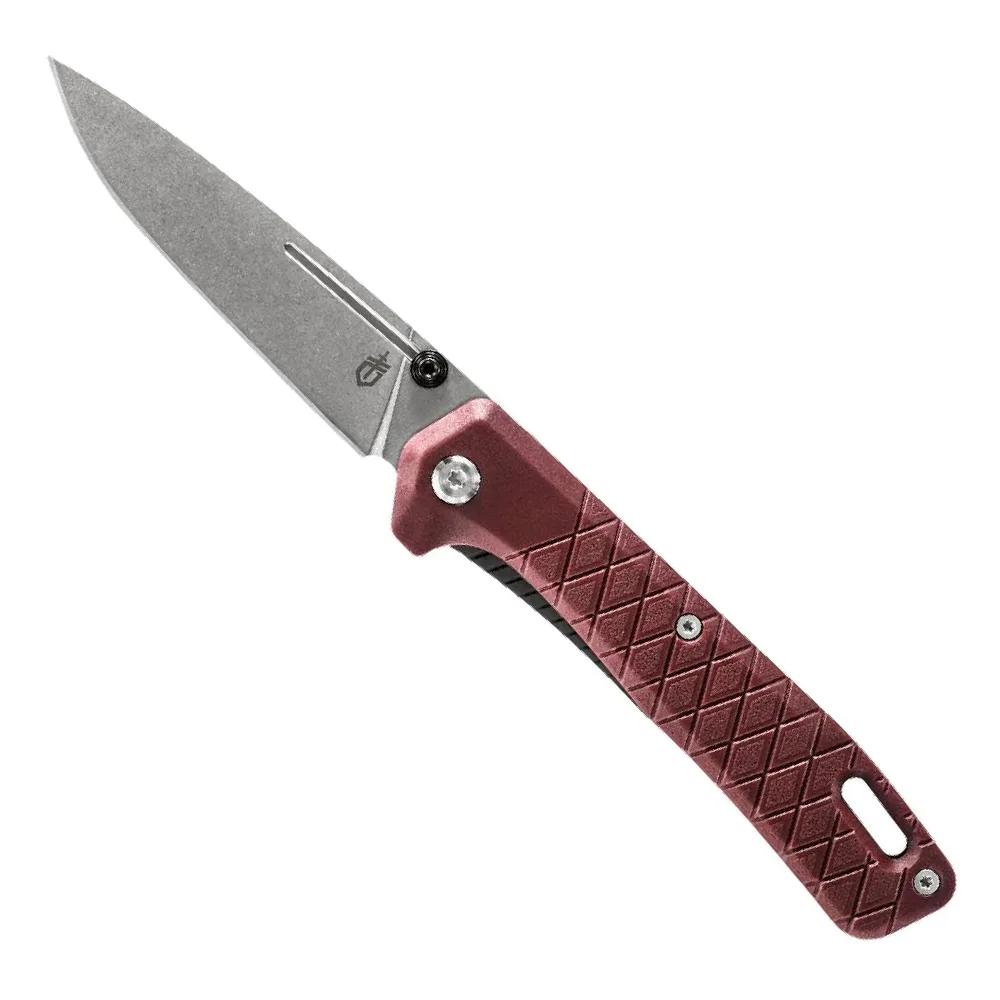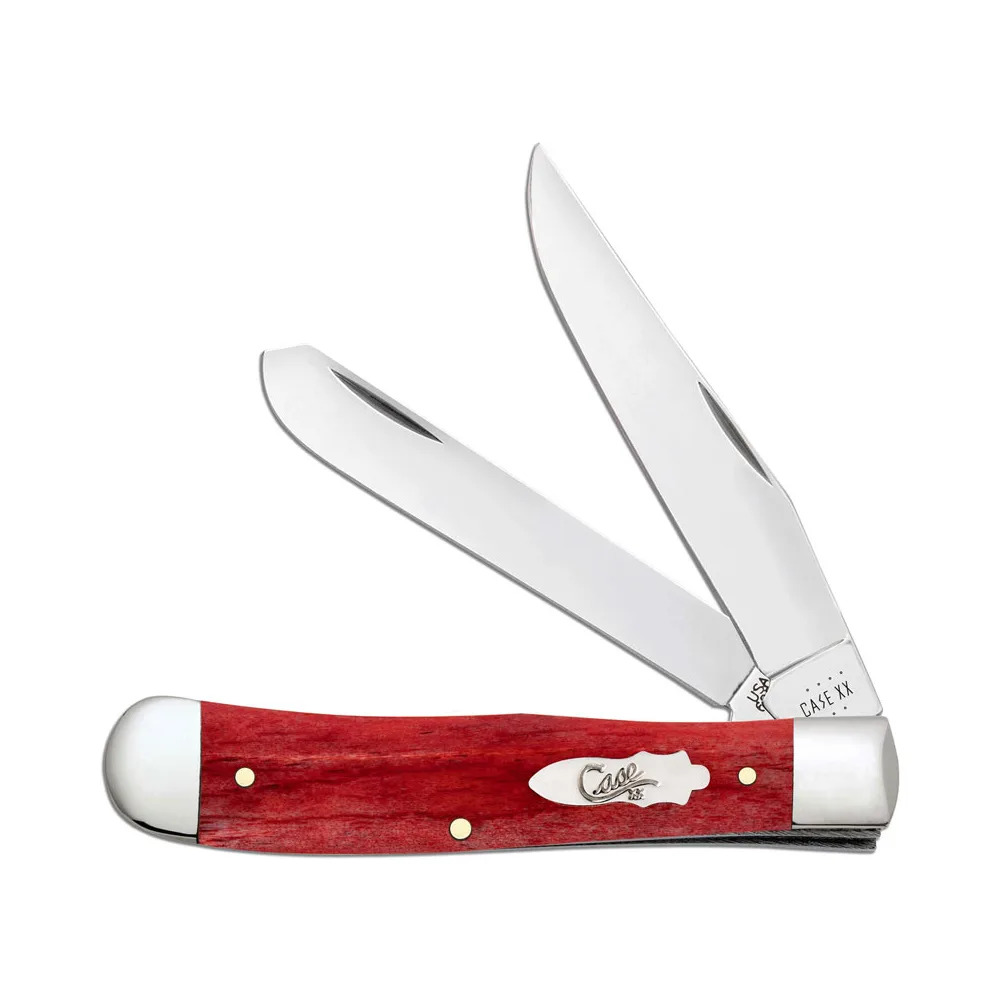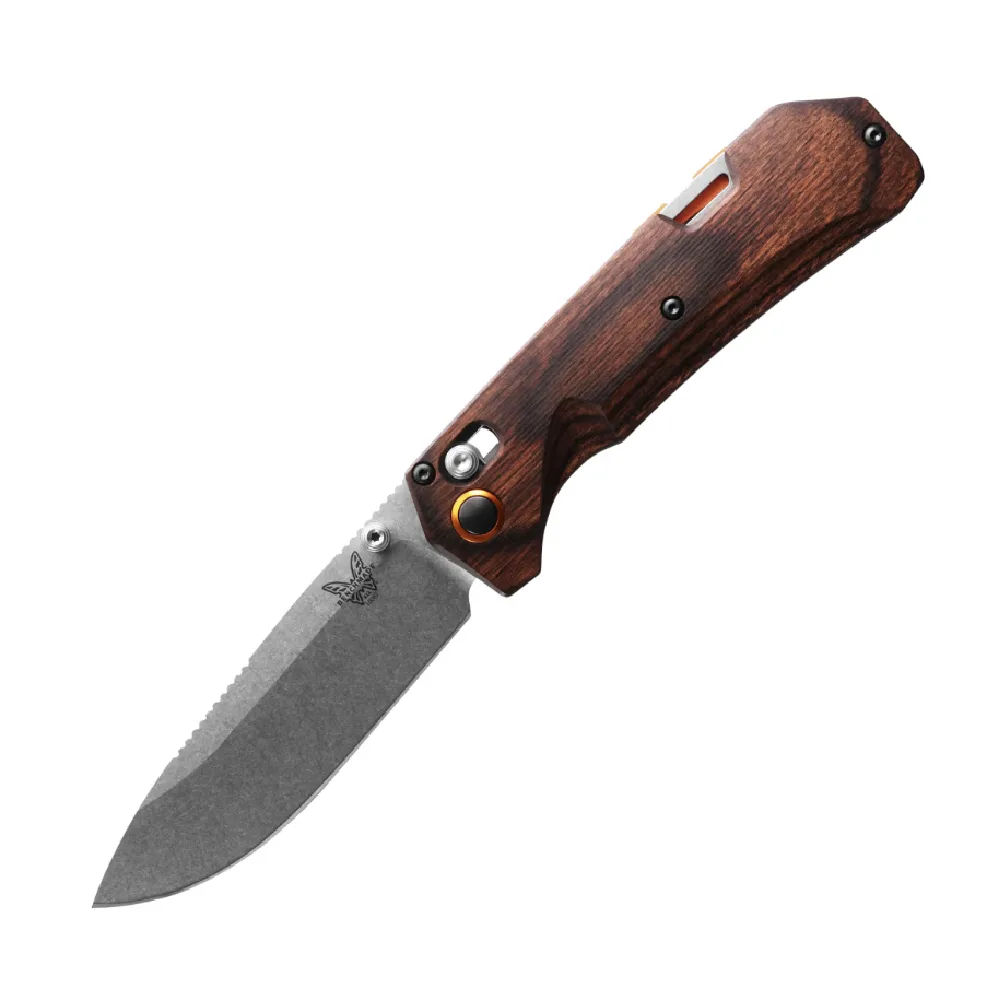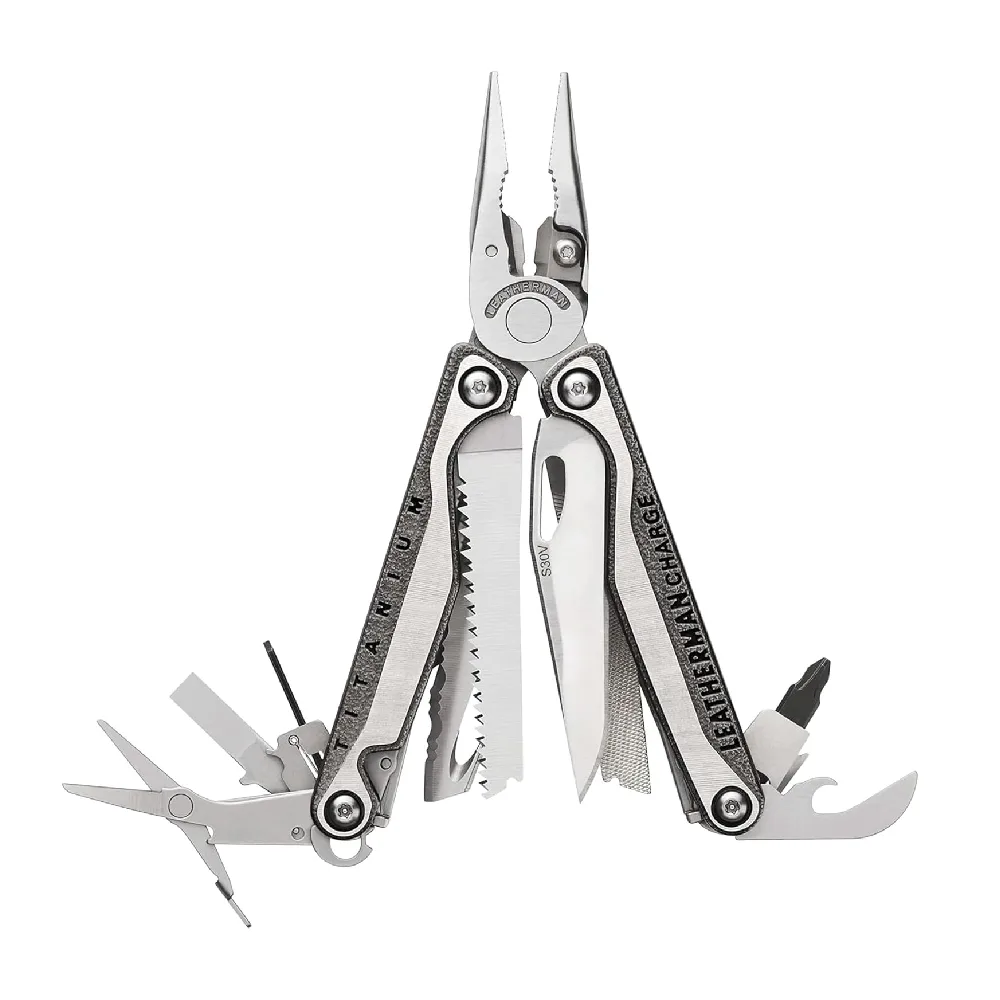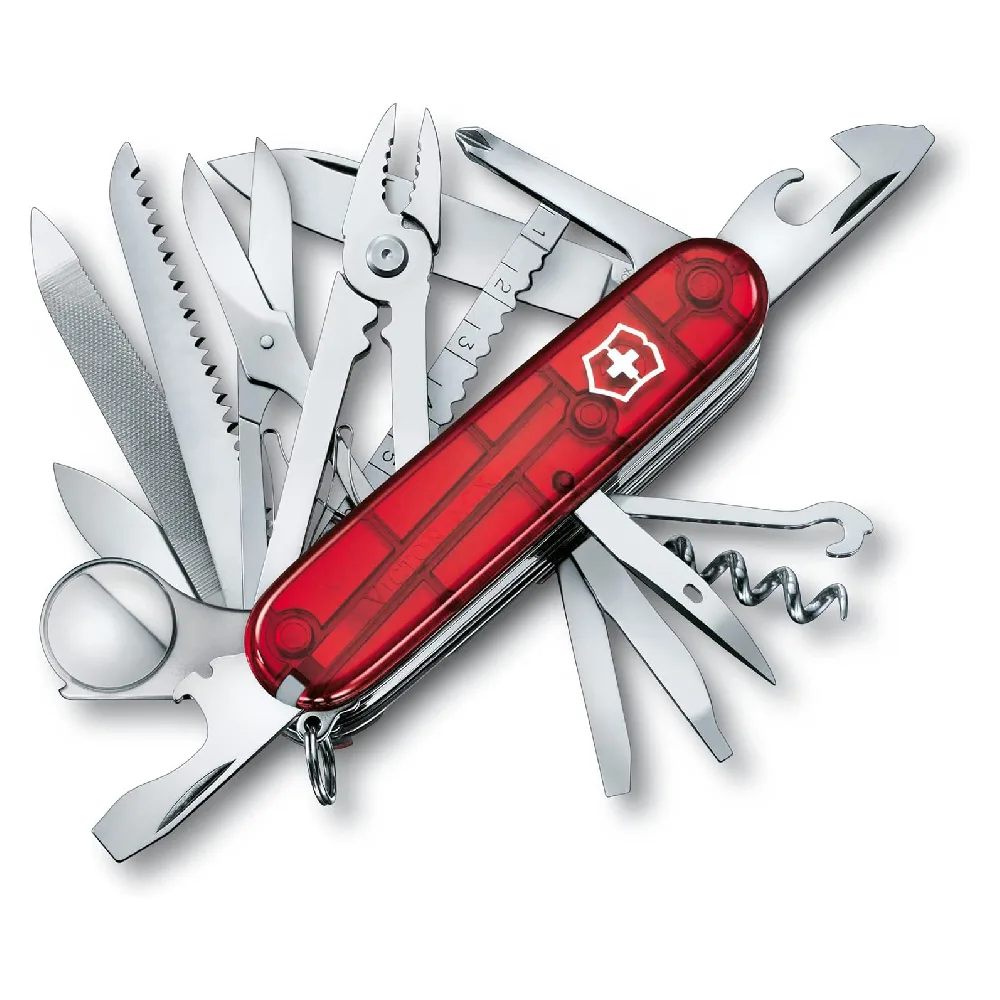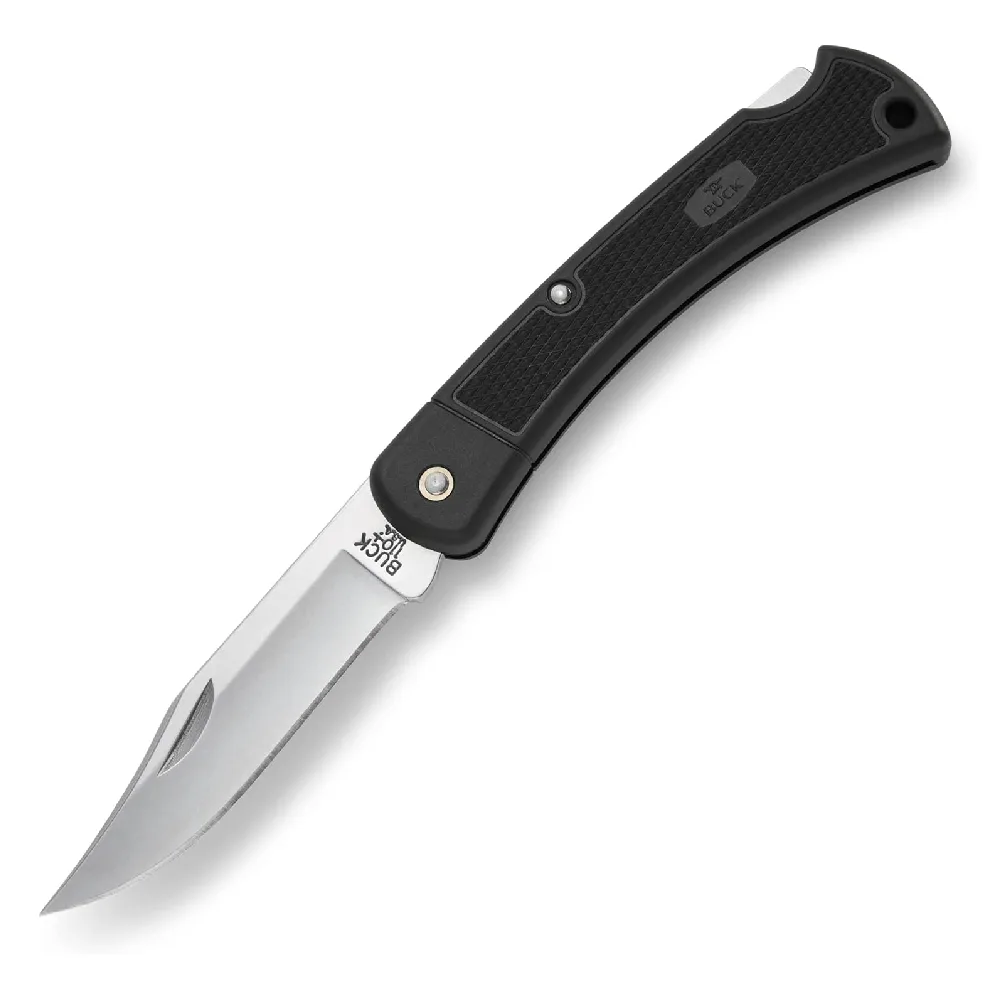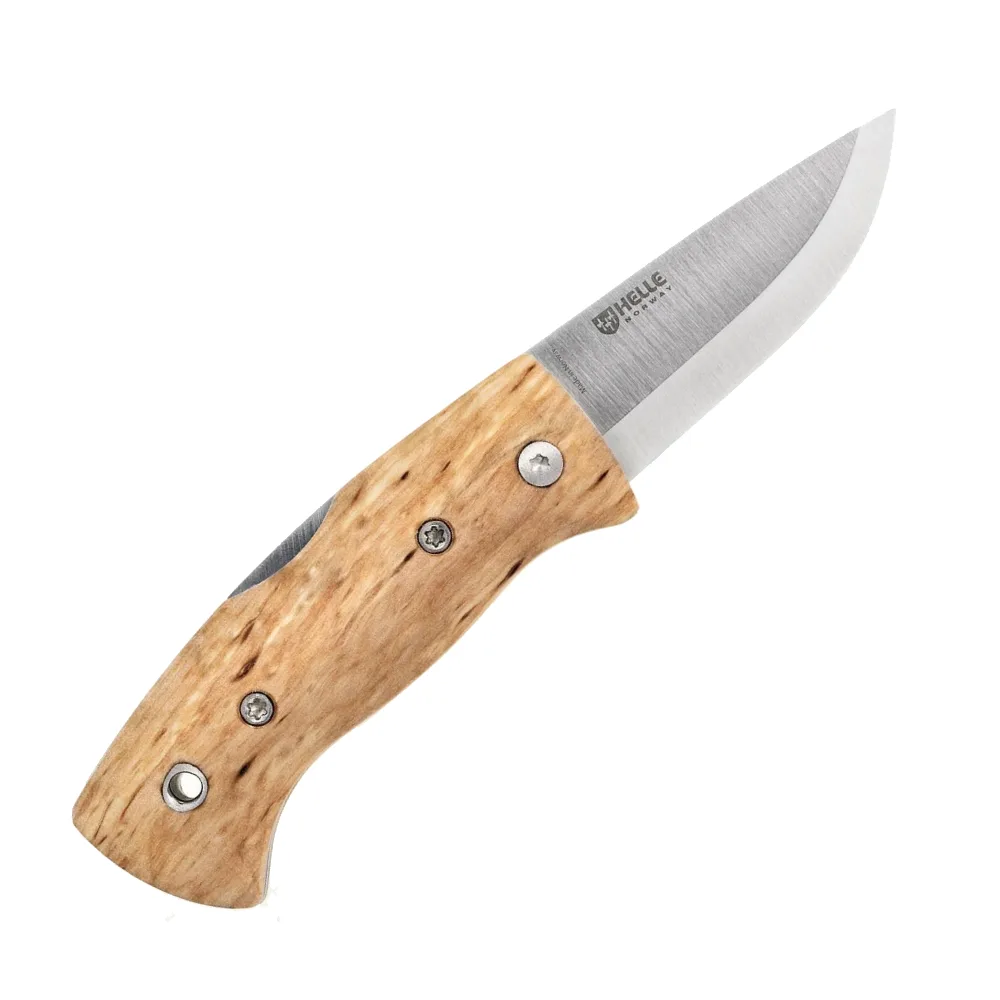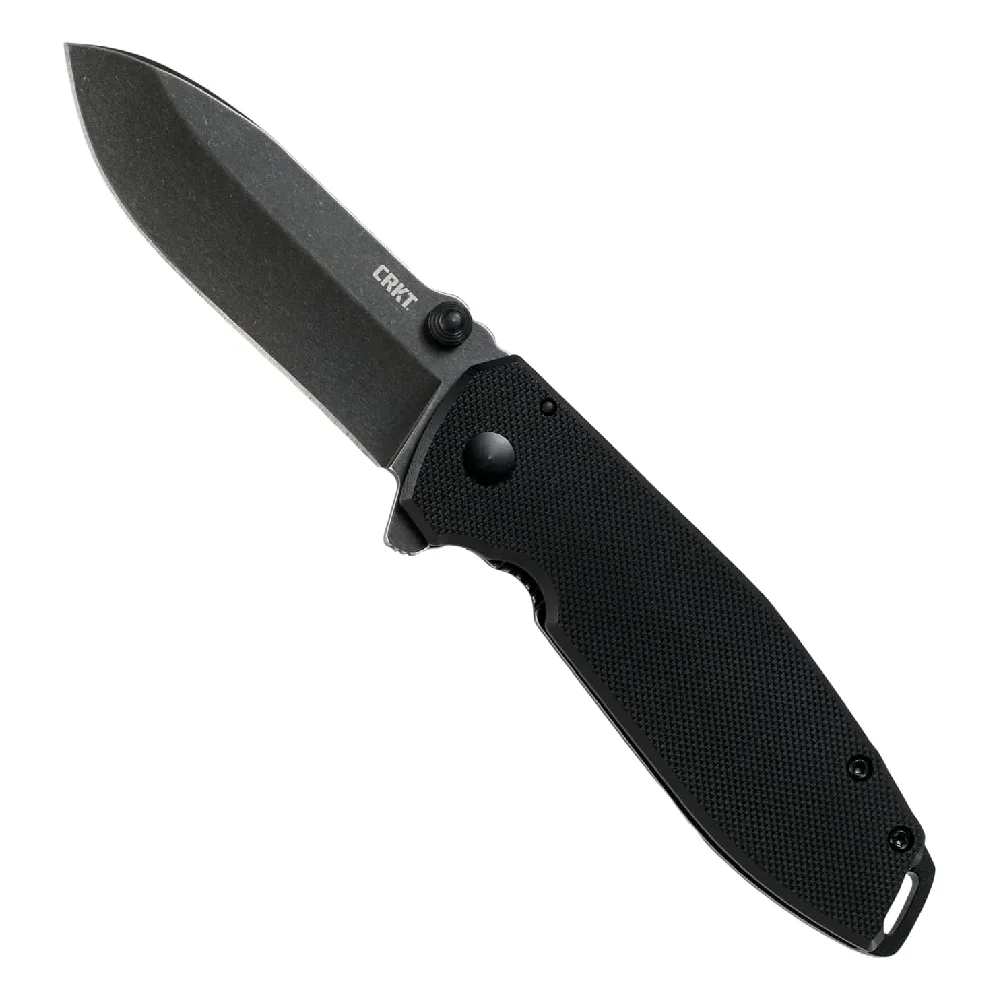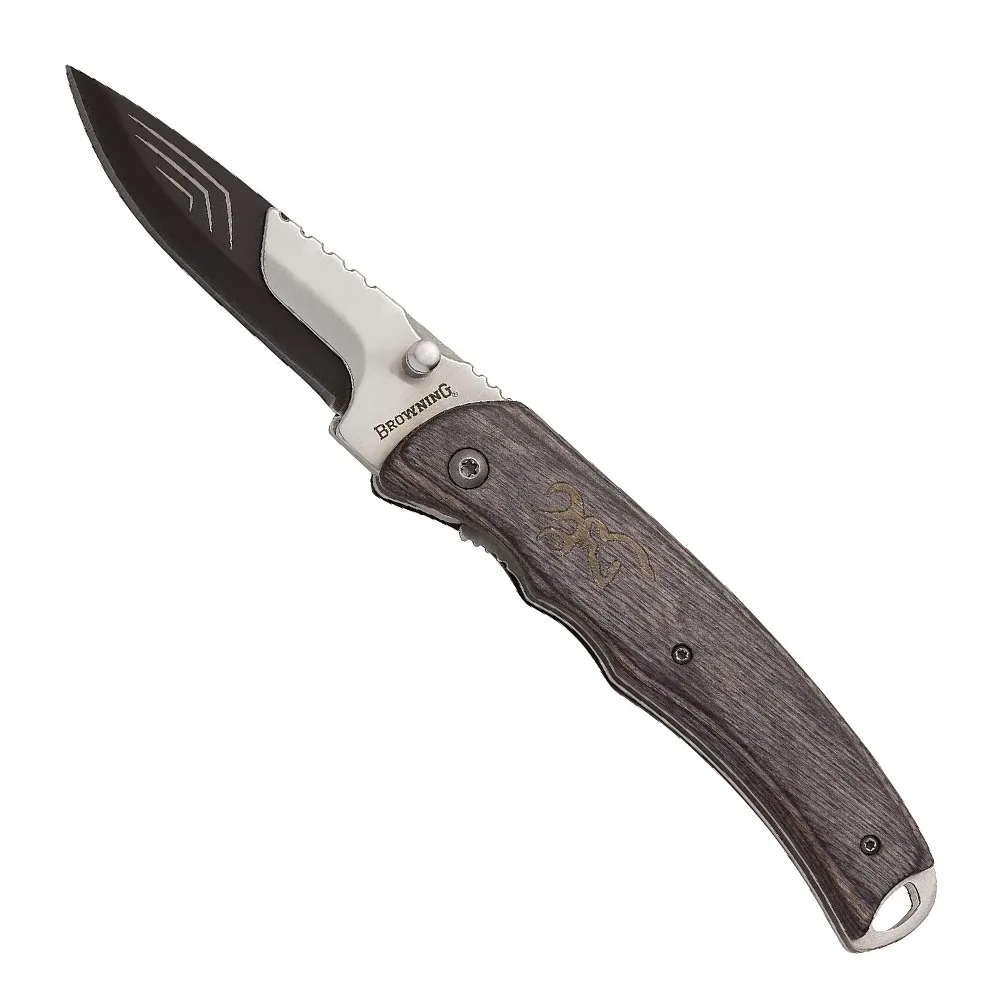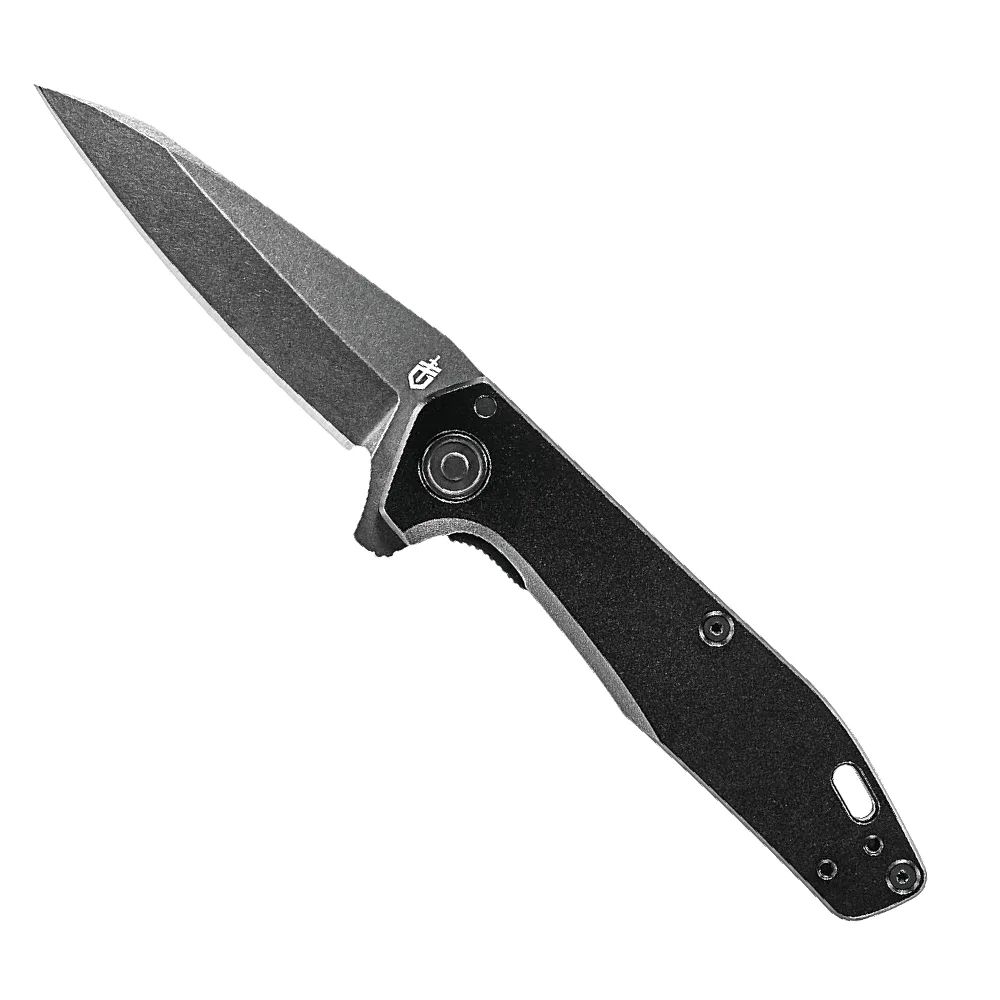We may earn revenue from the products available on this page and participate in affiliate programs. Learn more
What makes the best pocket knife? Well, it has to ride easily in the pocket of your favorite pants for starters, but when you take it out, it also has to do exactly what you want it to. There are endless designs and styles of pocket knives, but determining what is best for you can be difficult. You might want something hyper-functional, as in a multi-tool that does what any knife would do, and more. Maybe a simple blade to handle those tasks that pop up every day. Or something that just feels right in your hand. Either way, you need to figure out what you want your knife to do before you start looking at different models.
To help, our editors got together and compiled a list of the best pocket knives you can buy right now. They drew on their lifetimes of outdoor experience to shorten the learning curve, and ensure you end up with the perfect blade.
Best Overall: Benchmade Griptilian
Best Budget: Opinel No. 08 Carbon Steel
Best Made in USA: Case Trapper
Best for Hunting: Benchmade Grizzly Creek
Best Multi-Tool: Leatherman Charge Plus TTI
Best for Camping: Victorinox Swiss Champ
Best Ultralight: Gerber Gear Zilch
Best Classic: Buck Knives 110 Folding Hunter
Best with Sharpest Blade: Helle Kletten
Best Small: CRKT Squid
Best with Replaceable Blade: Browning Speed Load
Best Mid-Sized: Gerber Gear Fastball
Best Overall: Benchmade Griptilian
Why it Made the Cut: As the best pocket knife overall, Benchmade’s Griptilian easily tackles the chores you’re likely to encounter on a day-to-day basis. The drop point blade opens and closes quickly, and the clip keeps it at the ready.
Specs
Steel: S30V
Blade: 3.45-inch drop point
Lock Type: Sliding Axis lock
Pros
Opens and closes quickly one-handed
Pocket clip swaps for right- or left-side carry
Nylon handle with diamond checkering provides plenty of grip
Cons
You pay for quality, and it’s expensive
I’ve been using one of the earliest models of Benchmade’s Griptilian since it was introduced almost 20 years ago. In that time, it has endured more than its fair share of abuse. I once left it on the bumper of my work truck, and it ended up on the shoulder of a busy road. Despite being run over several times, this Benchmade knife continued to function as it should. In fact, the only damage was some road rash on the handle.
A 3.45-inch blade is sized appropriately for most tasks you’re likely to encounter on a daily basis, and stays just under the size limit imposed by certain municipalities. The S30V steel in the blade holds an edge well, letting you go a long time between visits to a sharpening stone. You can get the Griptilian with both plain and partially serrated edges, which is perfect for those that might have cut through tough cordage.
The innovative sliding Axis lock lets you easily open and close the knife one-handed, so you can cut your way out of a bind even with one hand occupied. The clip adjusts for both right- and left-side tip-up carry, letting you keep it on your strong side, whichever that may be. Opening boxes, cutting up an apple, or skinning a squirrel, the Griptilian can handle it. —Joseph Albanese
Best Budget: Opinel No. 08 Carbon Steel
Why it Made the Cut: As far as folders go, it doesn’t get much simpler than the Opinel No. 08. It’s one-blade design and utilitarian locking mechanism keep it budget-friendly, but it’s not a cheap throwaway. It’s the perfect EDC companion for hunters, anglers, or anybody who needs to carry a blade.
Specs
Steel: XC90 carbon steel
Blade: 3.28-inch clip point
Lock Type: Friction of the clamping band
Pros
Easy to sharpen in the field
Lightweight
Cheap enough to replace easily if you lose it
Cons
You need to use two hands to open it
Blade is not stainless, so watch out for saltwater
No matter how many hunting knives I buy, I always come back to the Opinel No. 08 Carbon Steel folder. Designed in 1890, the knife was originally distributed to farmers and train conductors in France. Opinel wanted to make an affordable, high-quality knife that would stand up to the rigors of rural life, and the fact that the company has sold over 300 million of them, should stand as a testament to that.
I first bought an Opinel No. 08 when I was broke and needed a good, sharp blade to field dress deer. But even when I could afford better knives, this one stayed in my pack. Its carbon-steel blade will dull if you nick a bone, but you can easily bring it back to shaving-sharp with a few passes on a wet stone or ceramic rod.
Opinel makes a few versions of this knife now, but in my opinion, the carbon steel No. 08 is still the best. It’s about the perfect size, fits well in the hand, and is so lightweight, you almost forget it’s there. This of course can mean that you might forget where it is altogether, but No. 08s are so cheap, you can afford to have a few spares. —Matthew Every
Best Made in USA: Case Trapper
Why It Made the Cut: For starters, the Case Trapper made the cut because it’s an American icon—and has been for more than a century. This versatile folder has two blades: I use the clip blade for everyday tasks, and the spey blade for skinning. When it comes to EDC knives, the Trapper certainly isn’t very modern looking—which is exactly what I love about it.
Specs
Steel: Chrome Vanadium
Blades: 3.24-inch clip blade; 3.27-inch spey blade
Handle: Yellow synthetic
Pros
Two versatile, and sharp, blades
Great value
Made in the USA
Cons
Super-smooth handle can be prone to falling out of pockets
Blades will rust or discolor without light maintenance
The Trapper is a knife that was originally designed for, well, trappers—outdoorsmen who needed an everyday-carry knife long before #EDC was common on social media. This pocket knife is about as simple as it gets: two full-length blades tucked into a strong synthetic handle. The clip blade is designed for the multi-purpose, everyday tasks, while the spey blade was made for jobs like skinning game…and castrating livestock. I’ve never used my Trapper for that last task, but I’ve used it on just about every other job. And on every one, the knife excelled.
Both blades are made from Chrome Vanadium steel, which holds a good edge and is easy to sharpen. However, the steel does require some maintenance. Unlike with stainless steel, you’ll want to keep a thin coat of oil on the blades to prevent rusting or pitting. Do that, and this is a pocket knife that’ll last you forever.
The Trapper has been around for so long that you can purchase it in just about every color or handle material imaginable—and limited-edition models are abundant. Personally, I prefer the classic Yellow Synthetic model. —Colin Kearns
Best for Hunting: Benchmade Grizzly Creek
Why it Made the Cut: Benchmade’s Grizzly Creek is everything you want in a folder for big-game hunting. It has a rock-solid locking mechanism and a drop-point blade made from high-quality steel that holds a wicked edge making it the best pocket knife for hunting.
Specs
Steel: S30V
Blades: 3.5-inch drop point, separate gut hook
Lock Type: Sliding Axis lock
Pros
Super-strong ambidextrous locking mechanism
Drop-point blade is perfect for gutting and skinning
Includes a folding gut hook for quickly unzipping game
Only 4.34 inches closed
Cons
It isn’t cheap
Not the easiest steel to resharpen
If I had to pick one folding knife to handle all of my field chores for the rest of my hunting days, it’d be the Grizzly Creek. Why? Well, first, because it’s built tough enough to last that long and still be in fine shape to hand down. Second, the S30V steel is perfect for someone like me, who can be a little lazy about sharpening and cleaning. Third, life is too short to hunt with an ugly knife, and this one’s composite Diamondwood scales have the look and warmth of traditional wood but is a tougher material. And finally, while this is an expensive knife, it’s not out of bounds for what you get.
The 3.5-inch flat-ground drop-point blade comes scary sharp out of the box and stays that way for a surprisingly long time. You can actually field dress and skin multiple critters with this thing before it really needs to be resharpened—or cleaned for that matter, as the S30V steel is extremely rust-resistant. The one downside is that it’s a little tricky to resharpen, but if you’re patient you’ll get the hang of it. (I recommend getting some quality sharpening rods for the job.)
The Axis lock is one of the strongest mechanisms ever developed, allowing for one-handed, ambidextrous opening and closing, and you get a non-locking gut hook with the Grizzly Creek, which is handy for quickly unzipping animals for field dressing. As pocket knives go, this one will take up a comparatively large portion of your pocket, but for an all-around hunting blade that can handle even large game, like elk, it strikes a nice balance between big enough and not too big. (If you want a slightly smaller folder that’s still suitable for deer, take a look at the North Fork, which is virtually identical to this one, minus the gut hook and close to a half inch shorter when closed.) The Grizzly Creek balances nicely, feels great in the hand, and its quality is obvious the second you put it there. —Dave Hurteau
Best Multi-Tool: Leatherman Charge Plus TTI
Why it Made the Cut: The Leatherman Charge Plus TTI stuffs 19 useful tools into a nearly-indestructible titanium chassis. Hunting, fishing, or on the jobsite, this one gets it done as the best multi-tool.
Specs
Steel: S30V, 420HC
Blade: Straight edge clip point, serrated, saw
Tools: 19 implements
Pros
Titanium construction is durable, and resists rust and corrosion
Blades can be opened from the outside
Pliers feature replaceable cutters
Removable pocket clip lets you ditch the sheath
Cons
Titanium is enduring, but expensive
Driver requires specific Leatherman bits
In the nearly two decades I’ve owned my Leatherman Charge TTI, I’ve used it for a wide variety of tasks including placing ear tags into freshly vaccinated raccoons, unhooking fish, untold repairs to the electrical system of an old Jeep, and replacing shear pins whenever I sent my duck boat just a little too hard. This multi-tool handled all these jobs with ease, and looks no worse for the wear.
The secret to the longevity is the titanium handles, which shrugged off abuse—and the ill-effects of the saltwater it was immersed in all too often. The only maintenance I ever performed was a couple of squirts of 3-in-1 oil into the plier’s joints to ensure it opened smoothly. If you don’t drop it in the brine, you can probably skip this step altogether.
The Charge TTI has since been replaced by the Charge Plus TTI. The new model builds on the excellent titanium chassis with a few new features to make it more useful. Perhaps most noteworthy is the replaceable wire cutters, which allow you to strip wire or cut fishing line without worrying about damage. The removable clip is a recent addition, and makes it easy to retrieve the multi tool when stuffed into a pocket. Like the original, you can still access the serrated knife, straight edge blade, saw, and file without opening the handles.
If you don’t need the strength and rust resistance of titanium, you can pick up the Charge Plus for less coin. —JA
Best for Camping: Victorinox Swiss Champ
Why It Made the Cut: The Swiss Champ more than lives up to its name. With this multi-tool on your belt or in your pocket, there’s not a camp chore you can’t conquer. Sure, not every single feature is exactly essential (I’ve yet to find one purpose for the “multipurpose hook,” for example), but the blades, saw, plier, and screwdrivers are all workhorses. And while the Champ might look bulky, it’s surprising how comfortably it fits in your pocket.
Specs
Steel: Stainless
Blades: 2 spearpoint knives; one large, one small
Tools: 33 different functions
Pros
Easy-to-sharpen blades
Durable construction; iconic design
Lifetime guarantee
Cons
Some may find it too bulky for EDC
Weak-ish plier
Slightly awkward to grip when using the large blade
If you were to Frankenstein a multi-tool and a classic folder, you’d get the Swiss Champ. I’ve been carrying around my Champ for about five years now, and, as much as I love my Leatherman, this is my favorite multi-tool to have at deer camp on camping trips. As F&S Rifles Editor, David E. Petzal, once wrote: “The Swiss Champ will solve more problems for you than two accountants, five lawyers, and a psychiatrist.”
The Swiss Army Champ has an impressive 33 different functions. There are two spearpoint blades—large and small. I use the small blade for a lot of utility work (cutting rope/cord, opening boxes, shaving kindling) and reserve the large blade for stuff that requires a longer runway. Both blades are easy to sharpen and won’t rust. Other regulars I rely on are the screwdrivers (there are six), the scissors, the (super-beefy) saw, and, of course, the toothpick. I’ve been surprised by how much I use the ball-point pen, and it is fun to start fires with a magnifying glass on a sunny day.
Up to this point in my life as a Swiss Champ carrier, I’ve yet to use the fish-scaler and hook—but you never know… One thing a Leatherman-style multi-tool has over the Champ is the plier. The set on the Champ is very puny by comparison.
Like most Swiss Army knives, the Champ does fit nicely and comfortably inside a pocket, but I prefer to wear mine on a belt sheath, which you’ll have to purchase separately. The Champ comes in a variety of colors and finishes—but you’d be nuts not to go with the iconic red. —CK
Best Ultralight: Gerber Gear Zilch
Why it Made the Cut: The worst thing about some pocket knives is that they’re in your pocket—in the way of everything else you’re trying to get at. The Gerber Zilch isn’t that kind of knife. It’s lightweight and all but disappears while you’re carrying it.
Specs
Steel: 7Cr Stainless Steel
Blade: 3.125-inch drop point
Lock Type: Liner lock
Pros
Lightweight and easy to carry
Opens easily the first time with no break-in period
Affordable
Cons
Not made for hard use
Folding knives clipped to the inside of your pocket can either be comfortable or downright annoying. I can’t stand knives that either skin the back of your hand every time you reach for your car keys or render your pocket unusable for anything else but that knife. The Gerber Zilch doesn’t do this. It’s slim and light, but not so slim that it doesn’t feel like a knife once you get it into your hand.
Gerber made the Zilch to be used right out of the box. The folding mechanism has nylon bushings that make opening and closing the knife buttery smooth. And there are two ways to open the knife—either with the dual thumb studs or a nail nick.
Above all else, the Zilch just looks good. The glass-reinforced nylon scales have a textured diamond pattern that’s grippy but not obnoxiously so, and the stone-washed matte blade gives it a modern appearance. I also appreciate other details that you don’t usually see on a $20 knife, like the interlocking tooth-like spine design and oversized lanyard hole. —ME
Best Classic: Buck Knives 110 Folding Hunter
Why it Made the Cut: Buck’s 110 just might be the most timeless folding knife in American history. The clip point stainless steel blade, brass bolsters, and ebony handle have stood the test time, serving outdoorsmen and women since it was first created in 1963.
Specs
Steel: 420HC stainless steel
Blade: 3.75-inch clip point
Lock Type: Lever lock
Pros
Simple, versatile design can gut a buck or fillet a bass
Solid brass frame looks as good as it feels
Excellent value
Cons
Tends to dull quickly
When my dad gave me my very first hunting knife in 1975, my eyes lit up. I’d saved up enough money cutting lawns to buy warm clothes, but didn’t have a knife. The Buck 110 was it and has become an American legend. It has been my go-to knife for both hunting and fishing for more than 40 years. I’ve lost it more than once, but it remains the only knife that I’ve headed back into the woods to search for—time and again.
Although I’ve found that the blade edge needs touching up on a regular basis, once it is honed well (using a good knife sharpener) you can do several deer before it loses its mark. This is not an ultra-lightweight folder if that’s what you’re looking for, but nor is it a heavyweight belt-tugging trudge. Well under $100. —GB
Sharpest Blade: Helle Kletten
Why it Made the Cut: The Helle Kletten is a true pocket-size knife that performs well above its diminutive form and is a thing of beauty in the bargain.
Specs
Steel: Proprietary Triple-Laminated Stainless
Blade: 2.17-inch drop point
Lock Type: Lever lock
Pros
Robust build for a small knife
Holds a keen edge and sharpens easily
Curly-birch handle is unique and distinctive; Kebony handle looks like plain wood but is stronger
Cons
It isn’t cheap for a small knife
If a knife can be adorable, this one is. At just over 3 inches closed, it’s a pretty little thing that fits in a pocket with room to spare. But its performance is all out of proportion to its size. The blade is thicker (⅛ inch) and deeper than what you see on most small folders. That combined with hand-filling scales, steel liners, and a strong manual back-lock mechanism makes the Kletton one of the toughest small knives you can buy, capable of chores usually left to larger models.
A Norwegian company known for making high-quality handmade knives, Helle uses a unique process in which they sandwich proprietary high-carbon steel between layers of 18/8 stainless to produce blades that are strong, corrosion-resistant, razor sharp, and easy to keep that way. The Kletton’s blade is a Scandinavian-grind 2.17-inch drop point designed for every-day chores but with the ideal profile for field-dressing and skinning if that’s what you need it to do.
It comes in two versions, the plain Kletton, which is anything but plain with curly-birch scales of which no two are the same; and the Kletton Kebony, with darker-wood scales that are strengthened via a proprietary process that the company says makes this tough, gorgeous little knife even tougher. —DH
Best Small: CRKT Squid
Why It Made the Cut: The CRKT Squid is a compact and durable knife perfect for everyday carry. It’s lightweight, low profile, and comes packed with helpful features like friction grooves and a lanyard hole.
Specs
Steel: 8Cr13MoV high-carbon stainless
Blade: 2.25-inch modified clip point
Lock Type: Frame Lock
Pros
Low profile and lightweight
Durable stonewashed finish
Thumb stud for easy opening with one hand
Cons
Short blade is not ideal for bigger projects
There are two things I look for in a strong EDC pocket knife—compatibility and durability. The CRKT Squid has both and it is always clipped to my belt. Now, this isn’t the knife you want for big projects, but in my opinion, it is ideal to have in your pocket for everyday tasks. The 2.25-inch blade is perfect for opening packages, making small cuts, and compact enough to carry on-the-go.
The Squid features a robust frame locking system and is made from stainless steel. A thumb stud allows for easy one-handed opening and the pocket clip and lanyard hole are perfect to make sure it stays secure to your person. And to put the cherry on top, this knife only costs $32. If you are looking for simplicity and usability, the CRKT Squid is your pick. —Ryan Chelius
Best with Replaceable Blade: Browning Speed Load
Why it Made the Cut: I hate gutting deer—always have, always will. It’s all part of the process, though, and ultra-sharp, replaceable blade, scalpel knives like the Browning Speed Load have made the chore far easier.
Specs
Steel: 420J2 stainless steel
Blade: 2.63-inch replaceable drop point
Lock Type: Liner lock
Pros
Blades are cheap and widely available
Outstanding handle that is durable and of great quality
Cons
Blade swap mechanism is cumbersome
Mixed reviews on blade quality and sharpness
Like most others, I guess, I first became enamored with replaceable-blade (scalpel) knives once Havalon came on the scene a decade or so ago. Suddenly, gutting a deer became a quick and simple procedure. After processing a few whitetails, however, I came to be more critical—pretty sharp, but also pretty flimsy.
Once I got my hands on the Browning Speed Load knife, though, I changed my mind. I carry it with me each deer season. Suddenly, the flimsiness was gone and I felt as if I was really holding a knife. The knife itself is sturdy, as are the blades. Although critics say that the blades do not remain sharp enough for long enough, I’ve not found that to be the case. Yes, I always carry the Buck 110 Folder for the tough stuff, but these days the Browning Speed Load does the heavy lifting. —Gerry Bethge
Best Mid-Sized: Gerber Gear Fastball
Why It Made the Cut: The Gerber Fastball is great for everyday carry, in the woods, and on the water. It features a Wharncliffe blade and aluminum handle.
Specs
Steel: High-carbon S30V
Blade: 3-inch Wharncliffe
Lock: Easy-off Liner Lock release
Pros
3-position pocket clip
Ball bearing leverage system
Limited lifetime warranty
Made in the USA
Cons
Limited accessories
When I think about what I want out of a pocket knife the answer is clear—simplicity. If I wanted a multitool, well, then I’d buy a multitool. But for a pocket knife, all I want is a strong, reliable, and compact blade that I can keep on me at all times. Enter the Gerber Fastball.
This knife is as simple as it comes without sacrificing quality. It measures 7.1-inches in total length with a 3-inch S30V stainless Wharncliffe blade for better precision. The aluminum handle is light at 2.7 oz., tailored for everyday carry. The stainless steel ball bearing system allows for a quick and smooth deployment. The blade itself—strong, durable, and corrosion resistant—is ideal for typical everyday tasks.
It’s not common to find many products made right here in the USA anymore, but the Gerber Fastball is. And there’s nothing more American than a perfect fastball. —RC
How We Picked The Best Pocket Knives
These are knives our editors have extensive experience with. We’ve each had our share of years and trips to get acquainted with these pocket knives, and they are the ones we’d put our money behind. Generally speaking, we were evaluating knives on these criteria:
Intended Use: Ultimately, the best pocket knife for you is the one that does the job you need. Heading out to camp and need a one-stop-shop, you’ll reach for a multi-tool. Backpacking and worried about every single ounce, you’ll go for an ultralight or small model. This portion is really up to the buyer, but then you’ll want a knife that can keep doing what you ask of it.
Durability: In the sense of a single knife, it’s how long you can expect this knife to keep up that intended use. If you need to hone a knife after every hunting trip, not great. If a blade starts to feel a little flimsy, or if a folding blade’s locking mechanism starts to feel a little wobbly, you’d stop picking that knife up.
Design: This is where the previous two criteria come together. For a replaceable blade, this is a blade that’s not just easily replaceable but widely available. For a fixed blade filet, it’s being easy to keep sharp. For a multi-tool, it’s having enough gadgets without being excessive. It’s what puts the best pocket knives in that “just right” sweet spot.
What To Consider When Choosing a Pocket Knife
Though all pocket knives are comprised with basically the same components, the way they are put together can vastly alter their usefulness for certain tasks. When looking for your next favorite knife, consider the following:
Blade Type
There are dozens of shapes you can have knife blades in. Some of these are highly specialized, designed to perform one specific task very well. Others are more generalist, and can handle a wide variety of chores well. For instance, a drop point can open a box, cut up lunch and skin a buck with equal ease. But while the unique shape of a fillet knife blade is perfect for separating delicate flesh from rib bones, it isn’t the best choice for cutting rope or making kindling. When looking for a knife, consider it’s intended usage, and select the blade shape accordingly.
Material
Perhaps no one single factor matters more for a knife’s performance than the type of steel it is made with. There are two types of steels used in knife blades, carbon and stainless. Carbon steel is strong and sharpens easily but is prone to rust. Stainless steel, as the name implies, offers more rust resistance. But, the compromise lies in its ability to take, and hold, and edge. For most pocket knives, a mix of the two is ideal. High-carbon stainless steels have acceptable sharpening and edge retention qualities, and resist rust without a daily oiling routine.
Additional Implements
Even if adorned with only a single blade, a pocket knife is no one trick pony. While it’s downright amazing what you can accomplish with the right blade, some additional tools at your disposal will increase the knife’s utility. An extra blade or two can greatly increase the knife’s usefulness. And multi-tools add another dimension, letting you perform repairs, build blinds, and start fires with a veritable toolbox that fits in your back pocket.
FAQs
Q: What is the best size pocket knife?
The best size for a pocket knife depends on its intended use. Most day-to-day tasks can be accomplished with a blade of around three inches. Blades of this size are small enough to be nimble, but have handles that offer enough real estate for a solid grip.But if you plan on taking on heftier tasks, such as cutting kindling, consider a slightly larger model.
Q: How much does a pocket knife cost?
A pocket knife can cost anywhere from a couple bucks to a few thousand. You can typically ignore knives on the lower end of that spectrum, with the exception of the outstanding Opinel, as these are typically poorly constructed and break quickly. You don’t need to spend a couple grand for a quality knife, either. Many excellent models are available in the $45 to $250 range.
Q: How long will a pocket knife last?
A good pocket knife can last forever with proper care. Assuming the knife is constructed of quality steel, with a solid mechanism, there is little to go wrong. Of course, if you abuse the knife by using it for a task it is not intended for, like prying, it will break. And you can eventually sharpen the blade down to nothing if you used it enough, but that will take quite some time.
Q: Is it safe to carry a pocket knife?
Yes, when the proper precautions are taken, it is very safe to carry a pocket knife. Make sure your pocket knife is safely secured to your person at all times. This means that it is either folded down or sheathed for safekeeping.
Q: Is it illegal to carry a pocket knife?
This depends on where you are and what type of knife you are carrying. In most states, it is perfectly legal to carry a folding pocket knife. Usually, a state will define a legal knife by the length of the blade and the type of knife. But you should still check your state and local laws to make sure you are legal to carry a pocket knife.
Final Thoughts
There are a variety of subjective factors that go into recommending the best pocket knives. Our team of editors have no shortage of heirlooms, stories, opinions, and experiences that went into creating this list. But the common theme in every selection is that each pocket knife does a good job at what that person needed it to do. Yes, there are important considerations like blade type, steel, and accessories you need to look for. Once you get these nuts and bolts squared away, make sure to tailor your selection to what you want your pocket knife to do.
Why Trust Us
For more than 125 years, Field & Stream has been providing readers with honest and authentic coverage of outdoor gear. Our writers and editors eat, sleep, and breathe the outdoors, and that passion comes through in our product reviews. You can count on F&S to keep you up to date on the best new gear. And when we write about a product—whether it’s a bass lure or a backpack—we cover the good and the bad, so you know exactly what to expect before you decide to make a purchase.

